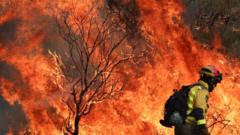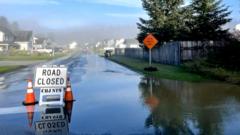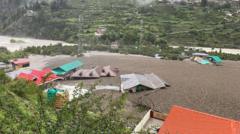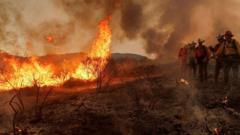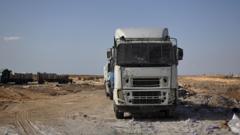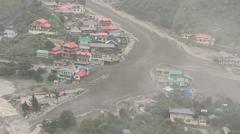In a tragic turn of events, Pakistan and Pakistan-administered Kashmir have witnessed an alarming rise in fatalities due to flash floods and landslides. Within the last 24 hours, at least 164 individuals have perished as relentless monsoon rains continue to pummel the region, with districts like Khyber Pakhtunkhwa bearing the brunt of the disaster.
Tragedy Strikes: Over 160 Lives Lost to Flash Floods in Pakistan and Kashmir
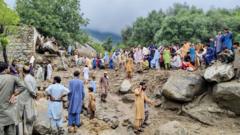
Tragedy Strikes: Over 160 Lives Lost to Flash Floods in Pakistan and Kashmir
Devastating monsoon rains lead to catastrophic flooding, claiming lives and causing destruction across northern regions.
Recent reports highlight that Khyber Pakhtunkhwa, known for its mountainous terrain, experienced 150 deaths according to local disaster authorities. The calamity also led to the destruction of at least 30 homes. A rescue operation suffered a severe setback when a helicopter, the M-17, tragically crashed due to adverse weather conditions, resulting in the loss of all five crew members onboard.
The crisis extends into Pakistan-administered Kashmir, where at least nine victims were reported, and the northern Gilgit-Baltistan region also recorded five fatalities. Government officials have issued warnings about heavy rainfall expected to persist until August 21, urging vigilance as several areas have been classified as disaster zones.
In Bajaur, officials witnessed chaotic scenes, with crowds gathering around excavators as they scoured through mudslides for the victims. A somber atmosphere enveloped the area, where funeral prayers were held for the deceased amidst blankets covering several bodies.
Separately, tragedy also struck in Indian-administered Kashmir, where rescuers have been laboring tirelessly to recover bodies from the rubble after a flood ravaged a Himalayan village, leading to at least 60 deaths. With monsoon rains from June to September accounting for a significant portion of South Asia's annual precipitation, the region typically experiences landslides and flooding during this period.
Notably, Punjab, home to nearly half of Pakistan's population, recorded a staggering 73% increase in rainfall compared to the previous year, compounding the current emergency with more fatalities than those logged during the entire previous monsoon season. Experts attribute the increasing severity and frequency of such weather events to climate change, raising concerns for the future well-being of the region.
The crisis extends into Pakistan-administered Kashmir, where at least nine victims were reported, and the northern Gilgit-Baltistan region also recorded five fatalities. Government officials have issued warnings about heavy rainfall expected to persist until August 21, urging vigilance as several areas have been classified as disaster zones.
In Bajaur, officials witnessed chaotic scenes, with crowds gathering around excavators as they scoured through mudslides for the victims. A somber atmosphere enveloped the area, where funeral prayers were held for the deceased amidst blankets covering several bodies.
Separately, tragedy also struck in Indian-administered Kashmir, where rescuers have been laboring tirelessly to recover bodies from the rubble after a flood ravaged a Himalayan village, leading to at least 60 deaths. With monsoon rains from June to September accounting for a significant portion of South Asia's annual precipitation, the region typically experiences landslides and flooding during this period.
Notably, Punjab, home to nearly half of Pakistan's population, recorded a staggering 73% increase in rainfall compared to the previous year, compounding the current emergency with more fatalities than those logged during the entire previous monsoon season. Experts attribute the increasing severity and frequency of such weather events to climate change, raising concerns for the future well-being of the region.


